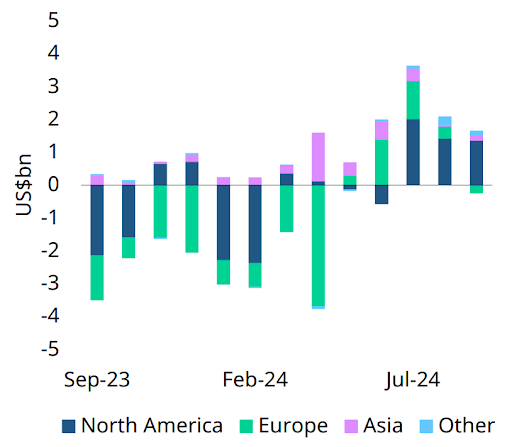Live Spot Gold
Bid/Ask
2,614.502,615.50
Low/High
2,603.902,653.50
Change
-27.60-1.04%
30daychg
+117.30+4.70%
1yearchg
+760.60+41.03%
Silver Price & PGMs

(Kitco News , Tuesday. Oct. 8th, 2024) – After a long hiatus, North American investors are finally taking a leading role in the gold rally, driving solid demand in exchange-traded funds (ETFs) in September.
In its latest report, the World Gold Council stated that 18.4 tonnes of gold, valued at $1.4 billion, flowed into global gold-backed ETFs in September. This marks the third consecutive month the precious metal has attracted investor inflows, transforming the marketplace.
“Continuous inflows in recent months have trimmed year-to-date (y-t-d) outflows of global gold ETFs, flipping positive to $389 million,” the analysts said in the report. “It is worth noting that year-to-date flows of North American funds have flipped positive, leaving Europe as the only region with outflows so far in 2024. Meanwhile, Asian funds continued to dominate global y-t-d inflows despite a recent slowdown in demand.”
Looking at regional demand, North American-listed funds saw inflows of $1.36 billion, accounting for most of the activity in the marketplace.
Analysts noted that North American investor demand improved sharply last month as the Federal Reserve aggressively cut interest rates by 50 basis points and signaled the start of a new easing cycle that could reduce rates to 3% by 2026.
“Lower opportunity costs, related to interest rates and the dollar, boosted investor interest in gold ETFs,” the analysts said in the report. “Similar to prior months, the surging gold price not only attracted investor attention but also led to the exercise of in-the-money call options of major gold ETFs, creating sizable inflows at the expiry date. Rising geopolitical tensions in the Middle East during the month, we believe, also helped attract gold ETF inflows as investors sought a safe haven.”
However, European gold funds saw outflows of 1.7 tonnes, valued at $244.9 million.
Analysts noted that diverging monetary policies between the Federal Reserve and the Bank of England could have prompted the shift among European investors.
“Outflows were mainly from UK funds. Compared to the U.S. Fed’s easing efforts, the Bank of England (BoE) was more reserved, leaving rates unchanged at 5% at their September meeting, citing the upside risk of inflation from elevated wage growth. The BoE’s cautious move cooled investor expectations of future rate cuts and fueled a sizable rebound in UK gilt yields, which coincided with major local gold ETFs’ outflows,” the analysts said. “In contrast, both Germany and Switzerland witnessed inflows, minor as they were, likely driven by safe-haven demand amid the deteriorating economic outlook, especially in Germany.”
While still relatively small, Asian-listed funds continue to stand out for their consistency. The report noted that Asian ETF holdings grew by 2 tonnes, valued at $175 million, in September. The region has seen net inflows for the last 20 consecutive months.
“India again saw strong inflows, driven by factors not too dissimilar from previous months. At the same time, the strong gold price momentum and elevated geopolitical risk were contributors. Chinese inflows were mild as the equity rally later in the month, fueled by the government’s aggressive stimulus package, diverted some investor attention away from gold despite its strong performance,” the analysts said.
Looking ahead, the World Gold Council expects that gold prices will continue to rally as the Federal Reserve continues to cut interest rates.
“[Gold] has historically returned an average of 6% in the six months following the start of rate-cutting cycles,” the analysts said. “Against a backdrop of high equity-bond correlation and shifting macro phases, the outlook for gold offers investors diversification and a hedge against broader portfolio risk. Add to this support from central bank buying, rising demand from key markets like India, the return of Western ETF investors, and the recent escalation in Middle East tensions, and gold is well positioned to benefit from these evolving market conditions.”
However, investors should also expect some volatility. A strong September employment report showed robust strength in the U.S. labor market, prompting markets to quickly shift their monetary policy expectations for next month.
Ahead of the employment report, which showed that the economy created 250,000 jobs last month, markets were pricing in a 30% chance of a 50 basis point rate cut. Since Friday’s data, markets now see a 90% chance of a 25 basis point cut, and a 10% chance of no rate cut next month.
Gold prices have struggled in this new environment. December gold futures last traded at $2,629.10 an ounce, down more than 1% on the day.
Posted by:
Jack Dempsey, President
401 Gold Consultants LLC
jdemp2003@gmail.com

